Abstract
Recently, the number of buildings with curved surfaces has been increasing. Although these buildings are not complex from a design perspective, they are thermally complex from an environmental engineering perspective. Computational fluid dynamics (CFD) is a tool used in environmental engineering analysis that requires advanced analysis techniques. Its analysis load is high, making its use impractical in design. Therefore, a coupled analysis method was developed using the two-dimensional heat flow calculation tool Hygrabe, energy simulation, and CFD. Using this method, the environmental analysis of a building with fill in Hokkaido, Japan, was performed and the accuracy of the analysis was verified. The results of the coupled analysis model were used to evaluate thermal insulation performance. The high thermostability of the fill contributes to the high degree of freedom of the exterior skin and is highly useful for design. The results show that the thermal performance of the building envelope with and without fill did not change the insulation performance. The results for January 15 were below −3.0 °C for all insulation performance levels but higher than the outside air temperature during the night.
1. Introduction
The rapid increase in the number of buildings with complex envelopes such as curved surfaces has gained growing attention in recent years [1,2]. However, simulating this type of thermal environment is difficult owing to its complexity. Although computational fluid dynamics (CFD) can be applied to thermally complex building envelopes, it is disadvantageous in terms of cost analysis and mesh division techniques, requiring skilled personnel. Most CFD analyses of building envelopes have focused on general envelopes; thus, a high degree of difficulty is expected. As unsteady calculations are important for design, energy simulation (ES) is suitable for these calculations and has been used in many studies, including those for energy calculations [3,4]. Moreover, CFD is suitable for approaching complex shapes. For example, a heat pump was analyzed by reproducing the shape of piping [5] and blood flow was calculated by reproducing the shape of blood vessels in the human heart [6]. The calculation of CFD alone has been used in many industrial fields. However, from the perspective of analysis load, only a limited number of cases exist whereby CFD can be investigated using only CFD. Therefore, a mechanism was devised to mutually complement the features of ES, which has a low analysis load, and CFD, which has a high analysis load.
Because ES and CFD are complementary, a coupled analysis of both was previously developed [7], applied to analysis techniques for large spaces [8], and even coupled with office equipment [9]. Recently, coupled analysis techniques, including equipment models, have also been investigated [10]. Research on the coupled analysis of ES and CFD has focused on the construction of highly accurate thermal environments and energy analysis models. However, such state-of-the-art technology has not been introduced into design practice and a coupled analysis technology that can approach design has yet to be fully developed. Therefore, a gap may exist in the technical approach of designers and researchers.
The thermal environment of a building is generally determined by its thermal insulation performance. Standards for thermal insulation performance vary across countries. In particular, in Japan, energy conservation standards are being revised to meet the sustainable development goals (SDG) [11], which are 17 targets adopted at the UN Summit that should be achieved by 2030. In the field of architecture, this involves “sustainable” buildings. Yamamoto et al. [12] developed an analysis method using a two-dimensional heat flow tool to calculate a thermally complex envelope for a raised building; the coupling of ES and CFD enabled the analysis of the thermal and design aspects of a thermally complex envelope. Convective heat transfer coefficients calculated using the dimensionless distance y+ have been used for accuracy verification. The results of y+ convective heat transfer coefficient studies have been verified by Yamamoto et al. [13] using the boundary layer theory, demonstrating that the optimal value of y+ was 100 when using the column basin as the reference temperature in a sensitivity analysis of y+.
Yamamoto et al. [14] further showed that velocity scales based on shear stress have a significant influence on the calculation of the convective heat transfer coefficient. Therefore, in this study, y+ was used to calculate the convective heat transfer coefficient. These data are valuable, given their scarcity in existing literature. Although Yamamoto et al. [14] provided insights into coupled ES and CFD analyses by using y+ reference temperatures to study convective heat transfer, the treatment of convective heat transfer coefficients in coupled ES and CFD analyses requires further discussion. In particular, research on the reference temperature has been limited. Although it has been established in wind tunnel experiments, such as the temperature of the incoming air as the reference temperature, the ideal definition of the reference temperature for a realistic phenomenon is to use y+ based on Prandtl turbulent mixing and the law of the wall.
Europe has strict standards for the insulation performance of minergie (Swiss Confederation since 1998.) [15]. Thermal insulation performance is a performance index used in Japan. Several research projects related to thermal insulation performance have been conducted, including numerical calculations based on the renovation of traditional Japanese houses [16] and examination of life-cycle cost [17] based on the analysis of buildings equivalent to the net zero energy house (ZEH) [18]. The Ainu pit dwellings, called “Toichise” [19], are used as materials for building envelopes and use geothermal heat for effective heat insulation in cold regions. In this study, the thermal insulation performance of a building envelope using geothermal heat was investigated.
Although several studies on thermal insulation performance exist in the architectural field [20], they are restricted to thermal factors and have a limited approach to design. Insulation performance is a determining factor in the environmental elements of an occupied space; however, no attempts have been made to approach its special geometries. The design approach to special geometries is often performed first, and the evaluation of insulation performance is limited to confirming that certain criteria are met. A previous study evaluated energy savings from phase change materials (PCM) and improved insulation performance [21]. Although PCMs have been used as an effective environmental approach, their use in design is limited. Research has focused on enhancing environmental performance rather than on practical application.
Recently, ES has been used to study insulation retrofits [22] and near-future weather data have been developed as its input conditions [23]. Meanwhile, meteorological data have been developed to represent the microclimate of urban city blocks, thereby allowing for more precise calculations of building performance [24]. The results of energy consumption calculations can significantly differ when considering microclimates, which is a highly important factor when designing future buildings.
The effects of modifying the ground level, which this study describes as the “presence” or “absence” of fill, on thermal insulation performance have yet to be elucidated. Therefore, this study aimed to evaluate the thermal insulation performance of fill by considering it together with the building’s frame and explore the range of possible applications of the presence and absence of fill on a building’s shape. Although the contribution of thermostatic properties of fills to the design is evident, the thermal properties themselves are unclear; hence, that was the focus of this study.
This study intends to provide insight into the effectiveness of fill effects and contribute to the design process of buildings with complex thermal envelopes to maximize and balance the performance of the design and thermal environments. Although this study is limited to a thermally complex envelope, the findings provide novel insights into a new environmental approach to design. Furthermore, this research aims to support, validate, and embolden designers who investigate and practice environmental engineering by providing a basic research foundation when using thermal insulation dynamics. Thus, the fusion of advanced thermal environmental simulation technology and design engineering is expected to elevate design to a new level. This study is novel because it confirms the sensitivity of the thermal environmental simulation method when applied to buildings with thermally complex-shaped envelopes.
2. Methods
2.1. Analysis Method
A simulation method for thermally complex envelopes was developed using the two-dimensional heat flow tool Hygrabe [25], a heat transfer model; the thermal environment of residential buildings for heat–air–moisture (THERB for HAM), a type of ES, [26]; and CFD. These are proprietary tools, hereafter referred to together as the thermal environment analysis method with thermally complex building envelopes (TEAM-TComBE). TEAM-TComBE is a coupled analysis method that employs a tool that calculates two-dimensional heat flow in eight directions as the boundary condition for the wall surface temperature of the ES. The values of advection between zones were based on Yamamoto et al. [12]; although those parameters are considerably larger than the customary values, some results differ significantly with respect to the forced convection field [27]. Therefore, the values from Yamamoto et al. [12] were used for advection between zones in ES, following a previously described method.
The flowchart of the coupled analysis is shown in Figure 1. In Step 1, the temperatures in eight orientations inside the wall were analyzed using a two-dimensional heat flow tool. In Step 2, the surface temperatures of the wall were calculated using THERB, with the boundary temperature calculated in Step 1 as the input condition. In Step 3, the surface temperature was calculated. In Step 4, unsteady calculations were performed using the physical quantities calculated in Step 3 as the boundary conditions for THERB. For the advection volume and convective heat transfer coefficient between zones, the results of the summer analysis in the study of Yamamoto et al. [12] were used as the THERB setting conditions. Because this study is intended to be a relative evaluation, the representative results for the summer season do not significantly affect the analysis results and discussion.
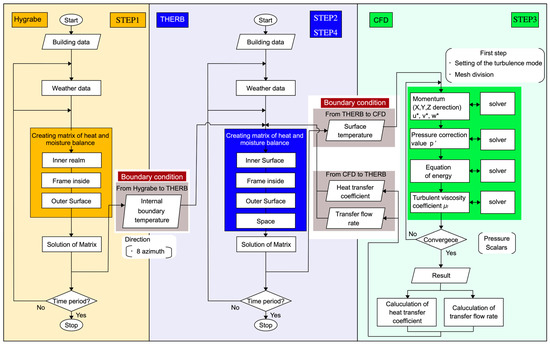
Figure 1.
Flowchart showing the thermal environment of residential buildings (THERB) and computational fluid dynamics (CFD) coupling of a two-dimensional heat flux calculation tool, following the method of Yamamoto et al. [12].
2.2. Analysis of Conditions and Study Cases
The analytical model of the THERB, which is modeled according to the two-dimensional heat flow calculation of the fill divided into eight directions, is shown in Figure 2. Because it is divided into five zones, the high temperature of the fill was recognized as previously described [12]. The temperature of Room 1 was used as a representative for comparison in this study because the temperature difference between the zones was small. With respect to the temperature inside the wall, the system is a mass point system; hence, the mass point is at the center of the division of the wall in the THERB calculation domain in Figure 2. The heat flow is calculated in two dimensions with respect to the thermal complex envelope.
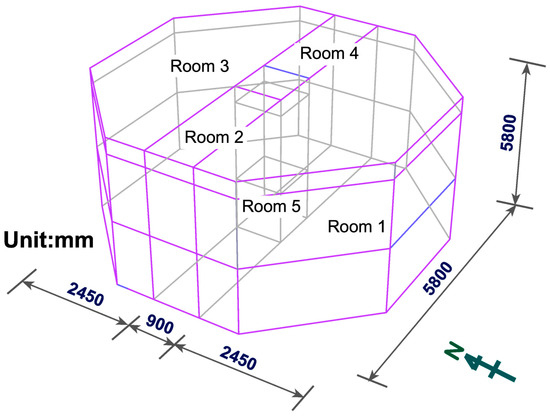
Figure 2.
THERB analysis model, adapted from Yamamoto et al. [12].
The building shape was modeled to match the shape of the fill. Radiation calculations were performed in THERB using the Hygrabe calculated surface temperature of the fill as a boundary condition. Thermally complex geometry refers to geometry that is difficult to analyze using ES. The scope of this study is broad and provides some information on the application of analytical methods to buildings with thermally complex envelopes.
Figure 3 shows a plan view and a cross-sectional view of the building. As shown in Yamamoto et al. [12], the fill and the frame are grounded. In the present study, the fill inclination angle in the figure varies according to the inclination angle of the fill. The slope angle of the fill is 60° in Figure 3, and the variables were assigned based on this angle. The target building was primarily selected because it is a building to which TEAM-TComBE can be applied. In particular, the model shown in Figure 2 and Figure 3 was selected because it is a building with a thermally complex envelope.
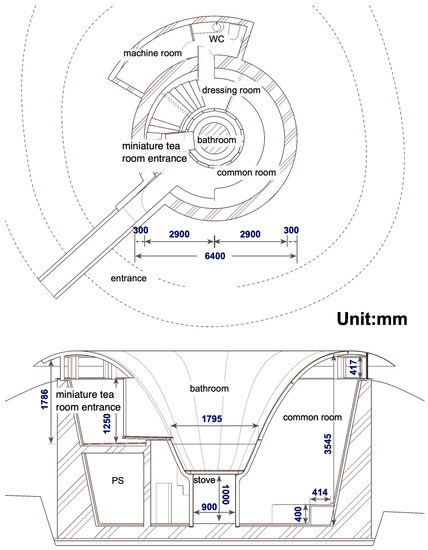
Figure 3.
Floor plan (top part) and cross-sectional view (lower part) of the studied building [12].
This study examined the effects of differences in thermal insulation performance based on the standards of Japan’s energy conservation [28], ZEH [15], and HEAT20 [29]. Hokkaido, Japan, is a region with cold winters and has strict standards for insulation performance: 0.46 [W/m2·K] for Building Energy Conservation Law, 0.40 [W/m2·K] for ZEH, and 0.28 [W/m2·K] for HEAT20 Grade 2. The U-values of the building envelope are defined as thermal insulation performance. The U-value is a generalized measure of the average heat loss per square meter of exterior skin that is obtained by dividing the amount of external heat loss escaping from the outer skin, which is the boundary between the inside and outside of the house, such as the exterior walls, roof, windows, and floors, by the surface area of the outer skin. For window surfaces, they are installed in all directions at the top of the outside wall.
Table 1 shows the wall structures used in Yamamoto et al. [12]. The insulation was assumed to be inserted between the mortar and concrete of the outer wall (inner → outer) and was adjusted to each insulation performance standard. For the other parts of the building, the insulation materials were similarly changed. For the window surfaces, the performance of the windows was changed. Table 2 shows the alterations of the type and thickness of insulation materials to meet the insulation performance standards of Hokkaido.

Table 1.
Wall structure of the building with a thermally complex envelope, as adapted from Yamamoto et al. [12].

Table 2.
Setting conditions for thermal insulation corresponding to thermal insulation performance at each site.
The calculation model of THERB is shown in Figure 1. Coupled calculations were performed by aligning the eight divided surfaces with each other. Although steel plates covered the rock wool, the design took condensation countermeasures and confirmed that no condensation occurred in the building after construction was completed. In addition, the building was covered with fill, which minimized moisture inflow.
Table 3 lists the analytical conditions for Hygrabe and THERB. The conditions were similar to those described by Yamamoto et al. [12] because the results obtained in the summer period were no different from those of the representative. All cases were analyzed under natural conditions because the aim was to determine basic insulation performance. A comparison of the thermal insulation performances with and without the fill was conducted. The inclination angle of the fill was set to 0° on the horizontal plane, which was an extreme case. A 365 d analysis was chosen for consistency with Yamamoto et al. [12] and to allow for seasonal comparisons. The Hygrabe and THERB analysis also appeared to benefit from a longer run-in period to ensure validity. Figure 4 shows the annual trend of solar radiation from AMeDAS. Solar radiation peaked in the summer and was lowest from December to January. In addition, this study had no internal gain and the analysis assumed natural conditions. The reason why people were not present in the building was because the aim was to compare the performance of the building in its natural state, as this study is an extension of a previous study [12]. Because various studies have examined situations in which people were not present in the building, this study also assumed that there was no internal gain, as is consistent with the purpose of the study.

Table 3.
Analysis conditions for Hygrabe and THERB [12].
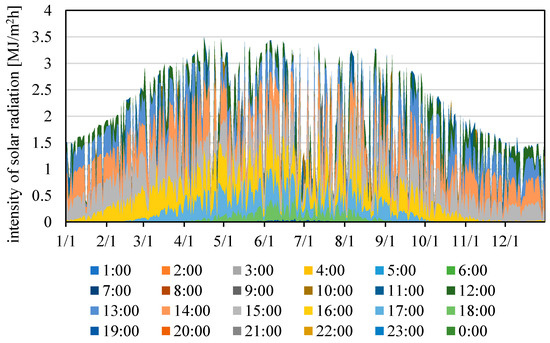
Figure 4.
Changes in solar radiation.
3. Results and Discussion
The analysis was conducted during winter, summer, and intermediate periods when the fill was at the maximum and minimum. Maximum fill was calculated by Hygrabe for the exterior skin when the horizontal direction was 0°. Minimum means that a small amount of fill was placed on the exterior wall for calculation purposes.
3.1. Results of the Analysis for 15 January
Figure 5 shows the influence of the difference in thermal insulation performance with and without fill. With maximum fill, the room temperature was stable and high, owing to the heat insulation performance of HEAT20. The temperature difference was in accordance with the insulation performance. Room temperature was not significantly affected by outside air temperature. Without fill, a difference of up to 4 °C was observed. The thermal lag in room temperature with respect to the outdoor air temperature was attributed to the large heat capacity of the fill.
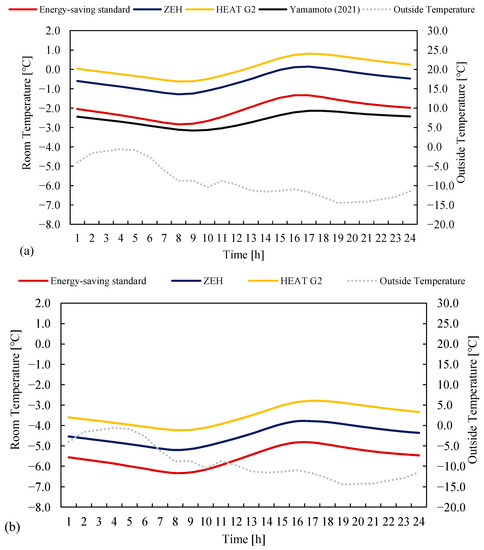
Figure 5.
Analysis results for 15 January. (a) Maximum fill and (b) without fill.
3.2. Results of the Analysis for 15 April
Figure 6 shows the influence of the difference in the thermal insulation performance with and without fill. For maximum fill, the case with HEAT20 insulation performance maintained the highest room temperature, and the difference in temperature between HEAT20 and ZEH was larger compared with that in January, demonstrating a large difference in insulation performance based on the season. The drop in temperature may be attributed to the high outdoor air temperature before the time of the cutout. The difference between ZEH and the energy-saving standard was small in the case without a fill, implying that without a certain level of insulation performance, the results would have been close depending on the range of insulation performance. The difference in room temperature was large with respect to the 15 April results. Due to the thermostatic nature of the fill, the room temperature was possibly influenced by the temperature effect of the previous day. In particular, compared with other months, the outside air temperature was lower even in April; thus, the insulation performance of the building may have contributed significantly to the difference in room temperature. Similarly, the reason why the room temperature decreased whereas the outdoor air temperature increased was because the previous day’s solar radiation was small and the previous day’s room temperature was affected by the high thermostability of the fill.
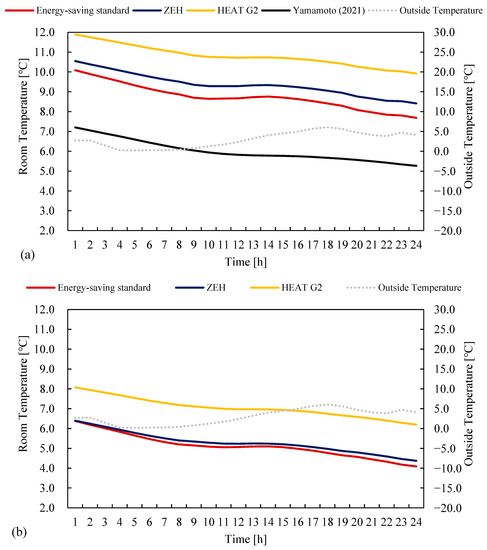
Figure 6.
Analysis results for 15 April. (a) Maximum fill and (b) without fill.
3.3. Results of the Analysis on 15 July
Figure 7 shows the analysis results for 15 July. The relationship between G20 and ZEH was similar to that in other seasons, except for the energy-saving standard. The temperature was highest immediately after the outdoor air temperature was high. This may have been due to the heat flow into the room owing to the low insulation performance. In contrast, room temperature decreased without any fill. In the case of the ZEH standard, the room temperature was lower than that reported by Yamamoto et al. [12]. However, the detailed effects of insulation performance in this area cannot be clarified without simple experiments; therefore, this study does not discuss them. The fill is extremely thermostatic, which causes a propensity for temperatures to be higher when the fill is at its maximum. This was anticipated given the low sun radiation in Figure 4 and the fill’s high thermostability. In other words, due to heat capacity, the room temperature without fill is lower when the outdoor air temperature is lower. Additionally, as the calculations were predicated on the premise that no one was in the room, the thermostatic qualities were expected to manifest themselves.
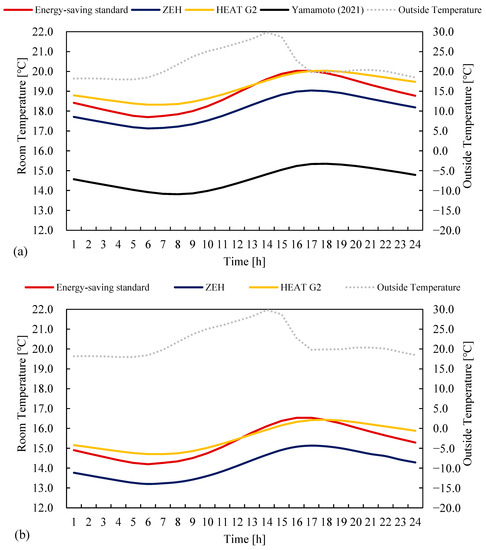
Figure 7.
Analysis results for 15 July. (a) Maximum fill and (b) without fill.
Figure 8 shows solar radiation and outdoor air temperature on 11 July. Without fill, the lower temperature was expected due to the lower room temperature on this day. In contrast, the maximum fill was expected to have a higher room temperature because it was more thermostatic and was not affected by the 11 July event. These considerations were strongly influenced by the low solar radiation around 1 July.
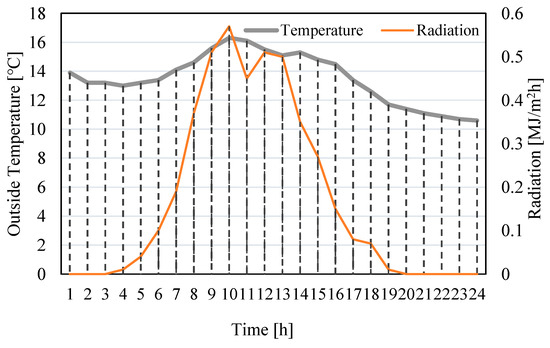
Figure 8.
Solar radiation and outdoor temperature on 11 July.
3.4. Generalization
Solar radiation influenced room temperature more than outdoor air temperature during all the seasons. In addition, because the differences in building insulation performance were significant with minimal fill, these data can serve as an indication of the thermostability of the fill. In considering building performance and design, the comparison of room temperatures clearly showed that some properties of the thermally complex envelope can influence insulation performance. The daily temperature fluctuations were approximately 2 °C and did not differ significantly regardless of the insulation performance. These results indicate that the major tendency of insulation performance was to shift the temperature phase with little difference in the waveform.
The degree of influence of thermal insulation performance on a building will be discussed. Using coupled analysis, a next-generation design that considers not only the design but also thermal factors can be created. Although this study was based on Japanese standards, it relied on thermal insulation performance and hence can be applied in other countries. The study was conducted under natural conditions to estimate the potential of insulation performance. Although the data were collected to reflect cold regions, the thermostability of the fill may also be beneficial in the summer season.
3.4.1. Comfort Rating
Table 4 shows the maximum and minimum comfort ratings. The activity was set at 1.1 met, clothing at 1.5 clo, maximum and minimum MRT at 18 °C, airflow velocity at 0.025 m/s, and relativity at 50%.

Table 4.
Comfort evaluation.
3.4.2. Analysis on 15 January
The predicted mean vote (PMV) and predicted percentage of dissatisfied (PPD) were proposed by Fanger as comfort indicators [30]. Many studies related to PMV have been performed, including those on insulation performance [31,32,33,34].
In January, the PPD generally exceeded 90% in the natural state with or without fill. For the energy-saving standard and ZEH without fill, the PMV value was below −3.0 [-], which is outside the applicable range. The outdoor temperature of Hokkaido during winter was extremely low; therefore, creating a comfortable environment was difficult, even in the presence of fill under natural conditions.
3.4.3. Analysis on 15 April
Although the environment in April was not as bad as that in January, the maximum PPD was 72% without fill. For the maximum fill, the PPD decreased to 25.04%, effectively demonstrating the effect of the fill during the middle period.
3.4.4. Analysis on 15 July
In July, the PMV was close to ± 0.5, regardless of the presence or absence of fill, suggesting that the effect of the fill does not change significantly if the insulation performance is above a certain level. The higher the insulation performance, the closer the value was to neutral. The presence or absence of fill was within the margin of error, with a difference of only 5%.
3.4.5. Verification of Fill Angles
Figure 9 shows the time series of PMV as a function of the inclination angle of fill. The high thermostability of the fill is indicated by the angle of inclination. The difference between 0° and 15° was significant, indicating that the effect of the thermostability of the fill was considerably high. The sudden drop in the PMV value may have been due to the effect of the outside air temperature. As this study performed a hypothetical comparison, it had no significant impact on the subject matter.
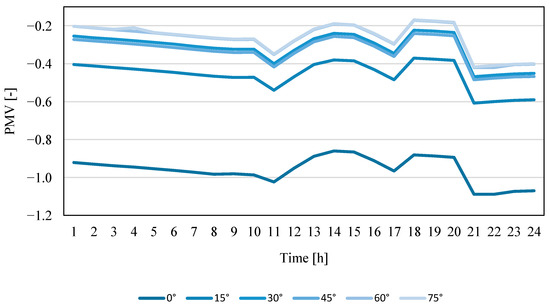
Figure 9.
Time-series change in comfort with the slope of the fill (0° was assumed to be no fill) 15 January.
Insulation performance was low in the design owing to the low value of PMV, which may be a concern. Hence, if this type of study was originally conducted prior to the design, an appropriate insulation performance could have been selected. Designs are moving into an era where evaluations are ultimately made based on human comfort, and PMV is an established metric and an appropriate indicator for this purpose.
4. Conclusions
In this study, the insulation performance of fill in a building was evaluated using the TEAM-TComBE method. Although presented largely from an applied-design perspective, the results are of interest to researchers and architects. The following conclusions were drawn from the study.
4.1. Results for the Winter Season
Outdoor air temperature has a stronger influence than the presence or absence of thermal insulation, thereby requiring the use of heaters, as shown by Yamamoto et al. [12].
4.2. Results for the Mid-Term Season
The outside air temperature was as low as 6–7 °C, despite being during the intermediate period, when the most effective results for fill were obtained. The presence of fill may allow for building heating with less energy consumption.
4.3. Results for the Summer Season
The most ideal results were obtained in the summer season when the PMV values were neutral and the outdoor air temperature was approximately 20 °C. The effect of the fill was not significant.
4.4. Heat Transfer Engineering Perspective on Wall Configuration and Internal Temperature
The thermostatic property of fill was strongly demonstrated by the outside air temperature of 6–7 °C during winter. This study was conducted following verification of accuracy.
4.5. Sensitivity of Indoor Comfort to the Effect of Fill Slope Angle
The thermostability of the fill as an exterior wall was evaluated. In addition, coupled analysis with the two-dimensional heat flow calculation tool was obtained as a solution; therefore, the data can serve as a means to approach the design of the built environment using ES, CFD, and two-dimensional heat flow calculation tools. This study showed that the analytical method can be applied to a wide range of scenarios, regardless of the type of fill. The thermal performance requirements of the building envelope become increasingly important annually; therefore, fill studies could provide essential information to future architects.
4.6. Challenges and Future Prospects
This study revealed some challenges. First, the results of the study are not yet generalizable because no advanced approaches have been made for different shapes. However, case studies of buildings with specific design features may be valuable. Second, the knowledge of coupled analysis remains insufficient. The results can help the database through applied studies and relative evaluation; however, the model for different building types must be improved. The database can be developed by analyzing several thermally specific building envelopes to construct a coupled analysis model that supports a balance between energy and design by introducing air-conditioning equipment models to the coupled analysis model such that energy can also be calculated. Further studies should be conducted to advocate for environmentally sound houses. Research projects that are not applied analyses, similar to this study, but are fundamental in nature as a base for designers to work from, should be promoted. For example, the contribution of different reference temperatures to the accuracy of convective heat transfer coefficients should be examined.
Funding
This research received no external funding.
Data Availability Statement
Not applicable.
Conflicts of Interest
The author declares no conflict of interest.
References
- Elbphilharmonie; Laeiszhalle; Hamburg. Available online: https://www.elbphilharmonie.de/de/ (accessed on 17 January 2023).
- Japan Sport Council. Available online: https://www.jpnsport.go.jp/newstadium/home/tabid/441/default.aspx (accessed on 17 January 2023).
- Yu, X.; Chen, C. Coupling spectral-dependent radiative cooling with building energy simulation. Build. Environ. 2021, 197, 107841. [Google Scholar] [CrossRef]
- Jia, H.; Chong, A. Eplusr: A framework for integrating building energy simulation and data-driven analytics. Energy Build. 2021, 237, 110757. [Google Scholar] [CrossRef]
- Liu, M.; Ooka, R.; Choi, W.; Ikeda, S. Experimental and numerical investigation of energy saving potential of centralized and decentralized pumping systems. Appl. Energy 2019, 251, 113359. [Google Scholar] [CrossRef]
- Perinajová, R.; Juffermans, J.F.; Westenberg, J.J.M.; van der Palen, R.L.F.; van den Boogaard, P.J.; Lamb, H.J.; Kenjereš, S. Geometrically induced wall shear stress variability in CFD-MRI coupled simulations of blood flow in the thoracic aortas. Comput. Biol. Med. 2021, 133, 104385. [Google Scholar] [CrossRef]
- Zhai, Z.; Chen, Q.; Haves, P.; Klems, J.H. On approaches to couple energy simulation and computational fluid dynamics programs. Build. Environ. 2002, 37, 857–864. [Google Scholar] [CrossRef]
- Ascione, F.; Bellia, L.; Capozzoli, A. A coupled numerical approach on museum air conditioning: Energy and fluid-dynamic analysis. Appl. Energy 2013, 103, 416–427. [Google Scholar] [CrossRef]
- Fan, Y.; Ito, K. Energy consumption analysis intended for real office space with energy recovery ventilator by integrating BES and CFD approaches. Build. Environ. 2012, 52, 57–67. [Google Scholar] [CrossRef]
- Fan, Y.; Ito, K. Integrated building energy computational fluid dynamics simulation for estimating the energy-saving effect of energy recovery ventilator with CO2 demand-controlled ventilation system in office space. Indoor Built Environ. 2014, 23, 785–803. [Google Scholar] [CrossRef]
- Ministry of Land, Infrastructure, Transport and Tourism. Available online: https://www.mlit.go.jp/jutakukentiku/shoenehou.html (accessed on 17 January 2023).
- Yamamoto, T.; Ozaki, A.; Kaoru, S.; Taniguchi, K. Analysis method based on coupled heat transfer and CFD simulations for buildings with thermally complex building envelopes. Build. Environ. 2021, 191, 107521. [Google Scholar] [CrossRef]
- Yamamoto, T.; Ozaki, A. Wall shear stress-based accuracy verification of convective heat transfer coefficient using velocity scale. In IECON 2021—47th Annual Conference of the IEEE Industrial Electronics Society, Proceedings of the 47th Annual Conference of the IEEE Industrial Electronics Society, Toronto, ON, Canada, 13–16 October 2021; IEEE Industrial Electronics Society: Piscataway, NJ, USA, 2021; pp. 1–5. [Google Scholar] [CrossRef]
- Yamamoto, T. Analysis of convective heat transfer coefficient using shear stress-based velocity scale. In E3S Web of Conferences; EDP Sciences: Les Ulis, France, 2022; p. 04025. [Google Scholar] [CrossRef]
- MINERGIE. Available online: https://www.minergie.ch/de/ (accessed on 17 January 2023).
- Yoshiura, A.; Nakazono, M.; Koganei, M.; Mizunuma, M.; Shiga, H. Numerical calculation of heating and cooling load and the effect of improving the thermal environment of traditional private houses by heat insulation repair and floor heating. J. Environ. Eng. AIJ 2013, 78, 333–340. [Google Scholar] [CrossRef]
- Akabayashi, Y.A.S.; Fusa, A. Research on zero energy house (Part 1): Examination of life cycle cost for all-electric detached house ZEH, monthly. J. Environ. Eng. Transac. AIJ 2021, 784, 638–648. [Google Scholar] [CrossRef]
- Agency for Natural Resources and Energy, (ZEH). Available online: https://www.enecho.meti.go.jp/category/saving_and_new/saving/general/housing/index03.html (accessed on 17 January 2023).
- Mori, T.; Nishizawa, T.; Kuwabara, K.; Satou, S. Thermal environment of chise and toichise in winter season. J. Environ. Eng. 2016, 81, 189–197. [Google Scholar] [CrossRef]
- Karanafti, A.; Theodosiou, T.; Tsikaloudaki, K. Assessment of buildings’ dynamic thermal insulation technologies—A review. Appl. Energy 2022, 326, 119985. [Google Scholar] [CrossRef]
- Abden, M.J.; Tao, Z.; Alim, M.A.; Pan, Z.; George, L.; Wuhrer, R. Combined use of phase change material and thermal insulation to improve energy efficiency of residential buildings. J. Energy Storage 2022, 56, 105880. [Google Scholar] [CrossRef]
- Pungercar, V.; Zhan, Q.; Xiao, Y.; Musso, F.; Dinkel, A.; Pflug, T. A new retrofitting strategy for the improvement of indoor environment quality and energy efficiency in residential buildings in temperate climate using prefabricated elements. Energy Build. 2021, 241, 110951. [Google Scholar] [CrossRef]
- Arima, Y.; Ooka, R.; Kikumoto, H. Proposal of typical and design weather year for building energy simulation. Energy Build. 2017, 139, 517–524. [Google Scholar] [CrossRef]
- Tang, Y.; Sun, T.; Luo, Z.; Omidvar, H.; Theeuwes, N.; Xie, X.; Xiong, J.; Yao, R.; Grimmond, S. Urban meteorological forcing data for building energy simulations. Build. Environ. 2021, 204, 108088. [Google Scholar] [CrossRef]
- Lee, H.; Ozaki, A. Sensitivity analysis for optimization of renewable-energy-based air-circulation-type temperature-control system. Appl. Energy 2018, 230, 317–329. [Google Scholar] [CrossRef]
- Ozaki, A.; Watanabe, T.; Hayashi, T.; Ryu, Y. Systematic analysis on combined heat and water transfer through porous materials based on thermodynamic energy. Energy Build. 2001, 33, 341–350. [Google Scholar] [CrossRef]
- Yamamoto, T.; Ozaki, A.; Lee, M.; Kusumoto, H. Fundamental study of coupling methods between energy simulation and CFD. Energy Build. 2018, 159, 587–599. [Google Scholar] [CrossRef]
- Institute for Building Environment and Energy Conservation (IBEC). Available online: https://www.ibec.or.jp/ee_standard/build_standard.html (accessed on 17 January 2023).
- HEAT, 20. Available online: http://www.heat20.jp/grade/ (accessed on 17 January 2023).
- Gagge, A.P.; Fobelets, A.P.; Berglund, L.G. A Standard Predictive Index of Human Response to the Thermal Environment. ASHRAE Trans. 1986, 92, 709–731. [Google Scholar]
- Broday, E.E.; Ruivo, C.R.; Gameiro da Silva, M.G. The use of Monte Carlo method to assess the uncertainty of thermal comfort indices PMV and PPD: Benefits of using a measuring set with an operative temperature probe. J. Build. Eng. 2021, 35, 101961. [Google Scholar] [CrossRef]
- Curto, D.; Franzitta, V.; Guercio, A.; Martorana, P. FEM analysis: A review of the most common thermal bridges and their mitigation. Energies 2022, 15, 2318. [Google Scholar] [CrossRef]
- Krause, P.; Nowoświat, A.; Pawłowski, K. The impact of internal insulation on heat transport through the wall: Case study. Appl. Sci. 2020, 10, 7484. [Google Scholar] [CrossRef]
- Romero, M.J.; Aguilar, F.; Vicente, P.G. Analysis of design improvements for thermal bridges formed by double-brick façades and intermediate slabs for nZEB residential buildings in Spain. J. Build. Eng. 2021, 44, 103270. [Google Scholar] [CrossRef]
Disclaimer/Publisher’s Note: The statements, opinions and data contained in all publications are solely those of the individual author(s) and contributor(s) and not of MDPI and/or the editor(s). MDPI and/or the editor(s) disclaim responsibility for any injury to people or property resulting from any ideas, methods, instructions or products referred to in the content. |
© 2023 by the author. Licensee MDPI, Basel, Switzerland. This article is an open access article distributed under the terms and conditions of the Creative Commons Attribution (CC BY) license (https://creativecommons.org/licenses/by/4.0/).